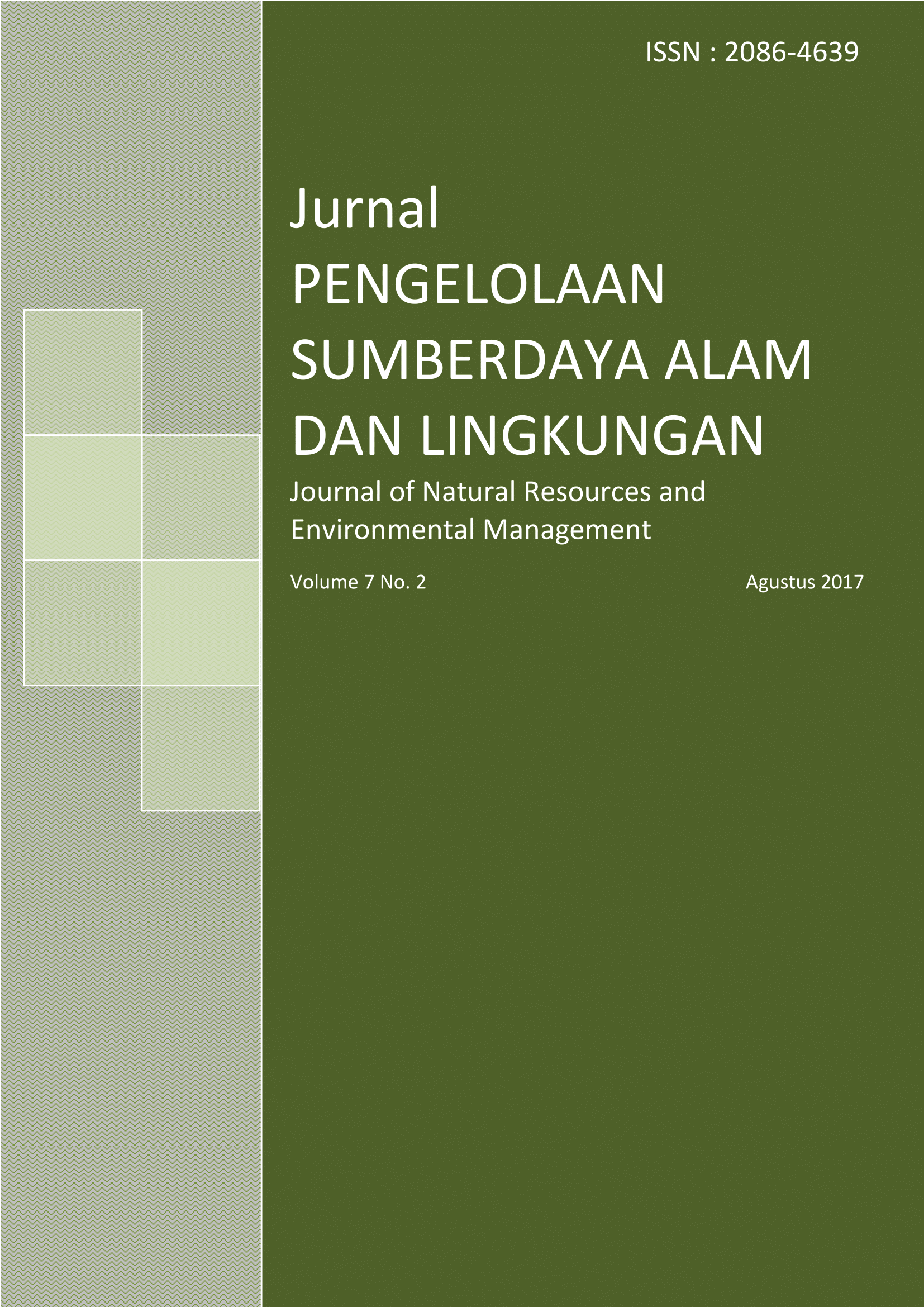ANALISIS CURAH HUJAN DAN DEBIT MODEL SWAT DENGAN METODE MOVING AVERAGE DI DAS CILIWUNG HULU
Abstract
Watershed can be regarded as a hydrological system that has a function in transforming rainwater as an input into outputs such as flow and sediment. The transformation of inputs into outputs has specific forms and properties. The transformation involves many processes, including processes occurred on the surface of the land, river basins, in soil and aquifer. This study aimed to apply the SWAT model in Ciliwung Hulu Watershed, asses the effect of average rainfall on 3 days, 5 days, 7 days and 10 days of the hydrological characteristics in Ciliwung Hulu Watershed. The correlation coefficient (r) between rainfall and discharge was positive, it indicated that there was an unidirectional relationship between rainfall and discharge in the upstream, midstream and downstream of the watershed. The upper limit ratio of discharge had a downward trend from upstream to downstream, while the lower limit ratio of discharge had an upward trend from upstream to downstream. It showed that the discharge peak in Ciliwung Hulu Watershed from upstream to downstream had a downward trend while the baseflow from upstream to downstream had an upward trend. It showed that the upstream of Ciliwung Hulu Watershed had the highest ratio of discharge peak and baseflow so it needs the soil and water conservations and technical civil measures. The discussion concluded that the SWAT model could be well applied in Ciliwung Hulu Watershed, the most affecting average rainfall on the hydrological characteristics was the average rainfall of 10 days. On average rainfall of 10 days, all components had contributed maximally for river discharge.
References
Arnold, J. G., Kiniry, J. R., Srinivasan, R., Williams, J. R., Haney, E. B., Neitsch, S. L., 2012. Input/Output Docu-mentation Version 2012. Texas (US), Texas Water Re-sources Institute.
Arnold, J. G., Gassman, P. W., White, M. J., 2010. New developments in the SWAT ecohydrology model. In Proc. 21st Watershed Technology Conf.: Improving Water Qual-ity and Environment. ASABE Publication No. 701P0210cd. St Joseph (US), ASABE.
Asdak, C., 2007. Hidrologi dan Pengelolaan Daerah Aliran Sungai. Yogyakarta (ID), UGM Pr.
[BPPP] Badan Penelitian dan Pengembangan Pertanian, 2013. Adaptasi Terhadap Variabilitas dan Perubahan Iklim Melalui Sistem Informasi Kalender Tanam Terpadu. [ter-hubung berkala]. http://www.deptan.go.id [22 Agustus 2016].
Mukid, M. A., Wilandari, Y., 2012. Identifikasi Pola Dis-tribusi Curah Hujan Maksimum dan Pendugaan Parame-ternya Menggunakan Metode Bayesian Markov Chain Monte Carlo. Media Statistika 5 (2), pp. 63-74.
Nash, J. E., J. V. Sutcliffe, 1970. River Flow Forecasting Through Conceptual Models Part I Discussion of Princi-ples. Journal of Hydrology 10 (3), pp. 282-190.
Riajaya, P.D. 2006. Sebaran Curah Hujan Sebagai Dasar Penetapan Waktu Tanam Kapas pada Lahan Sawah Sesudah Padi di Lamongan Jawa Timur. J
Perspektif 5 (1), pp. 26-35.
Sudiharto. 2004. Kelayakan Penerapan Metode Oldeman untuk Klasifikasi Tipe Hujan di Perkebunan Karet. J Penelitian Karet 22 (2), pp. 23-35.
Arnold, J. G., Gassman, P. W., White, M. J., 2010. New developments in the SWAT ecohydrology model. In Proc. 21st Watershed Technology Conf.: Improving Water Qual-ity and Environment. ASABE Publication No. 701P0210cd. St Joseph (US), ASABE.
Asdak, C., 2007. Hidrologi dan Pengelolaan Daerah Aliran Sungai. Yogyakarta (ID), UGM Pr.
[BPPP] Badan Penelitian dan Pengembangan Pertanian, 2013. Adaptasi Terhadap Variabilitas dan Perubahan Iklim Melalui Sistem Informasi Kalender Tanam Terpadu. [ter-hubung berkala]. http://www.deptan.go.id [22 Agustus 2016].
Mukid, M. A., Wilandari, Y., 2012. Identifikasi Pola Dis-tribusi Curah Hujan Maksimum dan Pendugaan Parame-ternya Menggunakan Metode Bayesian Markov Chain Monte Carlo. Media Statistika 5 (2), pp. 63-74.
Nash, J. E., J. V. Sutcliffe, 1970. River Flow Forecasting Through Conceptual Models Part I Discussion of Princi-ples. Journal of Hydrology 10 (3), pp. 282-190.
Riajaya, P.D. 2006. Sebaran Curah Hujan Sebagai Dasar Penetapan Waktu Tanam Kapas pada Lahan Sawah Sesudah Padi di Lamongan Jawa Timur. J
Perspektif 5 (1), pp. 26-35.
Sudiharto. 2004. Kelayakan Penerapan Metode Oldeman untuk Klasifikasi Tipe Hujan di Perkebunan Karet. J Penelitian Karet 22 (2), pp. 23-35.
Authors
ZumaD. S., MurtilaksonoK. and SuharnotoY. (2017) “ANALISIS CURAH HUJAN DAN DEBIT MODEL SWAT DENGAN METODE MOVING AVERAGE DI DAS CILIWUNG HULU”, Jurnal Pengelolaan Sumberdaya Alam dan Lingkungan (Journal of Natural Resources and Environmental Management). Bogor, ID, 7(2), pp. 98-106. doi: 10.29244/jpsl.7.2.98-106.
Authors who publish with this journal agree to the following terms:
- Authors retain copyright and grant the journal right of first publication with the work simultaneously licensed under a Creative Commons Attribution License that allows others to share the work with an acknowledgement of the work's authorship and initial publication in this journal.
- Authors are able to enter into separate, additional contractual arrangements for the non-exclusive distribution of the journal's published version of the work (e.g., post it to an institutional repository or publish it in a book), with an acknowledgement of its initial publication in this journal.
- Authors are permitted and encouraged to post their work online (e.g., in institutional repositories or on their website) prior to and during the submission process, as it can lead to productive exchanges, as well as earlier and greater citation of published work (See The Effect of Open Access).





